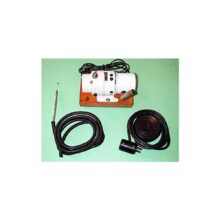Eye Surgery Instruments in the 19th Century: Precision with a Touch of Elegance
In the 1800s, eye surgeons used specialized eye surgery instuments to perform delicate procedures. These instruments often featured ivory handles, combining functionality with a touch of sophistication (at the time).
Ivory Handles: More Than Just Aesthetics
Ivory handles served a practical purpose beyond their elegant appearance. They were lightweight and easy to grip, allowing surgeons to manipulate the instruments with precision[1]. Additionally, the smooth texture of ivory provided a comfortable hold during lengthy operations.
Types of Instruments
Eye surgery kits from this era typically included a variety of tools:
1. Probes and hooks: Used to examine and manipulate delicate eye structures[1].
2. Picks: Employed for fine dissection and removal of small objects.
3. Scalpels: Essential for making precise incisions.
4. Retractors: Used to hold eyelids open during procedures[7].
Many of these instruments were crafted by skilled makers like Mayer & Meltzer, a London-based company established in 1875[1].
Advancements in Cataract Surgery
During the 19th century, eye surgery techniques evolved significantly. Surgeons moved away from the ancient “couching” method and adopted more advanced procedures like extracapsular cataract extraction (ECCE)[3]. This technique required a larger corneal incision and specialized instruments to remove the cloudy lens.
The Legacy of 19th Century Instruments
Today, these antique eye surgery tools provide valuable insights into the history of ophthalmology. Museums and collectors prize these instruments for their craftsmanship and historical significance[5]. While modern eye surgery has advanced tremendously, these 19th-century tools remind us of the ingenuity and skill of early ophthalmologists.
In conclusion, 19th-century eye surgery instruments with ivory handles represent a fascinating blend of medical innovation and craftsmanship. These tools paved the way for the precise and minimally invasive eye surgeries we benefit from today.
Citations:
[1] https://www.gilai.com/product_92/Set-of-6-Ivory-Handled-Opthalmic-Surgical-Instruments-19th-Century
[2] https://library.oapen.org/bitstream/id/71ac25ce-7e5d-444d-8a9b-feb3b5175197/978-3-030-78589-5.pdf
[3] https://heritageblog.rcpsg.ac.uk/2019/04/04/charriere-mid-19th-century-ophthalmic-surgical-instruments%EF%BB%BF/
[4] https://www.reddit.com/r/SCPDeclassified/
[5] https://www.vanleestantiques.com/product-category/medical-instruments/ophthalmology/
[6] https://marine.copernicus.eu/marine-paragraph/iframe-render/https:%7C%7Cxn--80ajnfqsfe5f.xn--p1ai%7Ckugimfjdtyzzfe46j
[7] https://archives.iu.edu/catalog/VAE1928aspace_34a4594ede47b98dd4558064a1f94638
[8] https://museum.wkhs.com/collections/medicine-in-the-new-south/19th-century-eye-surgery-instruments




